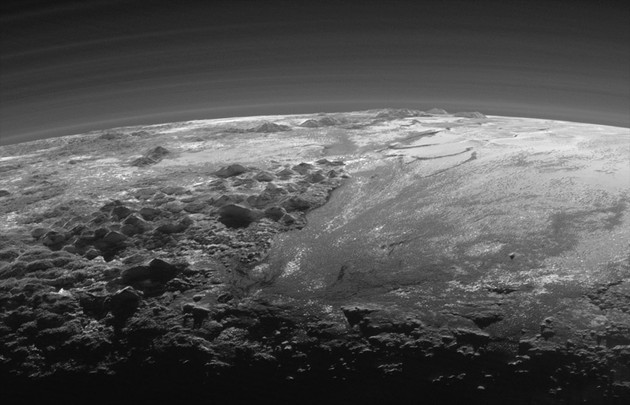The Outer Solar System BeckonsThe planets and moons that sit beyond the asteroid belt are becoming more intriguing by the week. Too bad we won’t see more of them for a long time.The Atlantic
Ross Andersen | 8:00 AM ET
 The icy surface of Enceladus, one of Saturn's moons. NASA
The icy surface of Enceladus, one of Saturn's moons. NASAThursday morning, my colleague Alan Taylor dropped into our company chat platform, to share two breathtaking images of Pluto, minutes after they were released by NASA’s New Horizons mission.
It’s not every day that you see, for the very first time, sunlight glinting off ice-encrusted mountains, on a world that sits more than 4 billion miles away. My colleagues and I were unanimous in our gasping, profane responses. There was a heart-eyed emoji, an “omg,” several instances of “Holy [poop]!” and even a “Just [intercourse gerund]WOW.”
Science writers on Twitter greeted the images with similar enthusiasm. “Drop everything and look at these Pluto pictures,” tweeted Emily Lakdawalla, from the Planetary Society. “Woah, Pluto” tweeted Michael Moyer, of Quanta. “Dang, these pictures of Pluto. We live in an astonishing age.” tweeted The New Yorker’s Kathryn Schulz.
The most charming and widely retweeted response came from planetary scientist Alex Parker, who works on the New Horizons mission. “Sunset on Pluto. Perhaps the most spectacular [image] I have ever seen,” he tweeted. And indeed, sunset on Pluto is spectacular:

And yet, sublime as they may be, the Pluto pics don’t even qualify as this week’s most interesting data dispatch from the outer solar system. On Tuesday, a team of scientists led by Cornell’s Peter Thomas published a paper confirming the presence of a subsurface ocean on Enceladus, one of Saturn’s moons. The ocean, you will recall, is where life is thought to have originated on our planet, Earth.
Planetary scientists have known that water flows beneath Enceladus’ icy outer shell since 2005, when NASA’s Cassini probe spotted plumes of vapor spraying out from cracks in its surface. But without further data, it was impossible to know how much water. Some suggested it might only be a thin layer of liquid. This new paper rules that possibity out. If there were only a small subsurface sea, the paper explains, Enceladus would be stiff on the inside. The moon wouldn’t wobble in the groovy way it does now, as it makes its way around Saturn.
Enceladus is only one of several intriguing ocean-harboring moons in the outer solar system. Titan, another of Saturn’s satellites, also has a subsurface ocean, albeit an especially salty one. And three of Jupiter’s moons host oceans, including Europa and Ganymede, whose underground seas contain more water than Earth’s.
There is a scenario in which the New Horizons mission could have served as a curtain raiser for a new era of solar-system exploration.
It would be nice to report that we have probes en route to these worlds. And it would be nice to report that those probes were rovers, equipped with drills that could bore through ice, to sample the oceans beneath, to look for life. But no such missions are on the books.
NASA has known about Europa’s ocean for nearly twenty years, but only in June did the agency approve a Europa mission concept for further development. And it’s an orbiter, not a rover, let alone a rover with a drill. The orbiter will tell us interesting things, and may even catch water droplets from the upper reaches of Europa’s sky. But we’ll be lucky if it launches before 2030.
And so, we’d better savor this week’s excitement. There is a scenario in which the New Horizons mission could have served as a curtain raiser for a new era of solar system exploration. But for a number of reasons—bad planning, cost overruns, political apathy—that scenario now looks like a fantasy. In the reality we inhabit, these last few Pluto images signal a curtain fall, and the start to a long, unnecessary intermission, in history’s greatest picture show. That’s a failure of imagination, one we’d do well to avoid the next time around.
http://www.theatlantic.com/science/archive/2015/09/the-outer-solar-system-beckons/406075/?utm_source=yahoo





















 Select your theme
Select your theme
